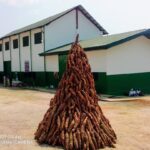The reception of a centrifuge and a refrigerator by the Laboratory Analysis Department of the centre announces the start of serious business, as the NBTS intends to operationalise its laboratory this year.
It is in line with its 2024 plan of action, that the top management of the National Blood Transfusion Service, NBTS is working relentlessly to see the laboratory of the centre go operational. The blood needs in Cameroon according to statistics stand at 400,000 pints. The ever-increasing demand warrants that the NBTS steps up its deployment on the field to bridge the gap. Thanks to funds disbursed by the Ministry of Public Health, the NBTS now owns a centrifuge which will enable the laboratory technicians to qualify blood once it is collected. While waiting to complete the equipment needed to run a full-time laboratory, the centre’s management is upbeat that with this structure in place, it will be on the path to achieving one of its central missions, which is making available quality blood products nationwide.
At the close of 2023, the Management Committee of the NBTS under Professor Tetanye Ekoe met in an ordinary session which saw the adoption of some CFA 765 million as the centre’s budget for 2024. According to Professor Dora Mbanya, General Manager of the centre, this would enable the NBTS continue its deployment on the field. At the structural level, the NBTS has regional representatives and while pending the construction of interregional blood transfusion centres, the President of the Management Committee opined that there is need for a vigorous and creative strategy to enable the rational use of material and equipment from the project to strengthen the blood transfusion system, PRESYNATS.
As the sole operator regarding regulating blood transfusion in Cameroon, the NBTS continues is on the offensive to get more partners onboard through sourcing of funds that will permit it deploy its machinery to all the parts of the country. So far, the NBTS has acquired funds optimise its data collection mechanism as well strengthen the capacities of some community workers engaged in the blood donation and sensitization chain. While hoping for better tidings, the centre’s management is leaving no stone unturned in its bid to meet fill the gap in blood supply, one of the important components of the country’s health system.
Claudette CHIN





